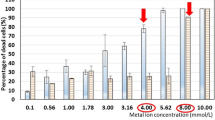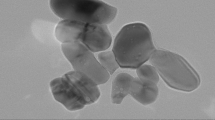Abstract
Cellular glutathione (GSH) was implicated in tolerance to potentially toxic metal(loid)s using two strains of Saccharomyces cerevisiae, a wild-type (Σ1278b) and a GSH-deficient mutant strain (gshA-2). Both yeast strains exhibited no significant difference in tolerance to tellurite, zinc, cobalt, copper, manganese, nickel and chromate. There was no marked influence of glutathione on the accumulation of Te, Co, Cu, and Mn, although the absence of cellular glutathione significantly increased the cellular content of Zn and Ni, but greatly decreased Cr content without significant alteration of tolerance. These results indicated the independence of cellular glutathione activity from tolerance to Te, Zn, Co, Cu, Mn, Ni, and Cr. However, involvement of glutathione in Zn, Ni and Cr uptake is possible. The glutathione-deficient strain displayed a high sensitivity to selenite and cadmium in comparison to the wild-type strain of S. cerevisiae. The minimum inhibitory concentrations of Se and Cd for the glutathione-deficient strain were 980 ±13 and 32 ±4 μM, respectively, whereas the wild strain tolerated up to 4080 ±198 μM Se and 148 ±5 μM Cd. A relationship between tolerance and reduced cellular content of both Se and Cd was also shown: the mutant strain accumulated approximately three-fold more Se and two-fold more Cd than that accumulated by the wild-type strain. This suggests an influence of GSH on cellular uptake of Se and Cd, and also directly confirms the protective action of such a cellular thiol compound against Se and Cd toxicity.
Similar content being viewed by others
References
Brady JM, Tobin JT, Gadd GM. 1996 Volatilization of selenite in an aqueous medium by a Penicillium species. Mycol Res 100, 955-961.
Bryson V, Szybalski W. 1952 Microbial selection. Science 116, 43-51.
Delhaize E, Jackson PJ, Lujan LD, Robinson NJ. 1989 Poly (γ-glutamylcysteinyl) glycine synthesis in Datura innoxia and binding with cadmium-role in cadmium tolerance. Plant Physiol 89, 700-706.
Dilworth GL, Bandurski RS. 1977 Activation of selenate by adenosine 5'-triphosphate sulphurylase from Saccharomyces cerevisiae. Biochem J 163, 521-529.
Elskens MT, Jaspers C, Penninckx MJ. 1991 Glutathione as an endogenous sulphur source in the yeast Saccharomyces cerevisiae.J Gen Microbiol 137, 637-644.
Gadd GM. 1993 Interactions of fungi with toxic metals. New Phytol 124, 25-60.
Gadd GM, Mowll JL. 1983 The relationship between cadmium uptake, potassium release and viability in Saccharomyces cerevisiae. FEMS Microbiol Lett 16, 45-48.
Gadd GM, Mowll JL, White C, Newby PJ. 1985 Methods for assessment of heavy metal toxicity towards fungi and yeasts. Toxicity Assess 1, 169-185.
Germann U, Lerch K. 1987 Copper accumulation in the cell walldeficient slime variant of Neurospora crassa. Biochem J 173, 5918-5920.
Gharieb, M.M. and Gadd, G.M. 1998 Evidence for the involvement of vacuolar activity in metal(loid) tolerance: vacuolar-lacking and-defective mutants of Saccharomyces cerevisiae display higher sensitivity to chromate, telurite and selenite. BioMetals 11, 101-106.
Gharieb MM, Wilkinson SC, Gadd GM. 1995 Reduction of selenium oxyanions by unicellular, polymorphic and filamentous fungi: cellular location of reduced selenium and implications for tolerance. J Indust Microbiol 14, 300-311.
Gharieb MM, Kierans M, Gadd GM. 1999 Transformation and tolerance of tellurite by filamentous fungi: accumulation, reduction, and volatilization. Mycol Res 103, 299-305
Grill E, Winnacker EL, Zenk MH. 1987 Phytochelatins, a class of heavy metal-binding peptides from plants, are functionally analogous to metallothioneins. Proc Nat Acad Sci USA 84, 439-443.
Karlson U, Frankenberger WT. 1993 Biological alkylation of selenium and tellurium. In: Sigel H, Sigel A, eds. Metal Ions in Biological Systems. New York: Marcel Dekker Inc.; 185-277.
Kneer R, Zenk MH. 1992 Phytochelatins protect plant enzymes from heavy metal poisoning. Phytochem 31, 2663-2667.
Kosman DJ. 1994 Transition metal ion uptake in yeasts and filamentous fungi. In: Winkelmann G, Winge DR, eds. Metal Ions in Fungi. Marcel Dekker: New York; 1-38.
Joho M, Inouhe M, Tohoyama H, Murayama T. 1995 Nickel resistance mechanisms in yeasts and other fungi. J Indust Microbiol 14, 164-168.
Lin CM, Crawford BF, Kosman DJ. 1993 Distribution of 64Cu in Saccharomyces cerevisiae: cellular locale and metabolism. J Gen Microbiol 139, 1605-1615.
Mehdi K, Penninckx MJ. 1997 An important role for glutathione and γ-glutamyltranspeptidase in the supply of growth requirements during nitrogen starvation of the yeast Saccharomyces cerevisiae. Microbiol 143, 1885-1889.
Mehra RK, Winge DR. 1991 Metal ion resistance in fungi: molecular mechanisms and their regulated expression. J Cell Biochem 45, 30-40.
Morley GF, Sayer JA, Wilkinson SC, Gharieb MM, Gadd GM. 1996 Fungal sequestration, mobilization and transformation of metals and metalloids. In: Frankland JC, Magan N, Gadd GM, eds. Fungi and Environmental Change. Cambridge University Press: Cambridge; 235-256.
Murasugi A, Wada C, Hayashi Y. 1981 Cadmium-binding peptide induced in fission yeast, Schizosaccharomyces pombe. J Biochem 90, 1561-1564.
Mutoh N, Hayashi Y. 1988 Isolation of mutants of Schizosaccharomyces pombe unable to synthesize cadystin, small cadmium-binding peptides. Biochem Biophys Res Comm 151, 32-39.
Nickerson WJ, Falcone G. 1963 Enzymatic reduction of selenite. J Bacteriol 85, 763-771.
Ohtake H, Kamari K, Cerevantes C, Toda K. 1990 Chromate resistance in a chromate-reducing strain of Enterobacter cloacae. FEMS Microbiol Lett 67, 85-88.
Penninckx MJ, Elskens M. 1993 Metabolism and functions of glutathione in microorganisms. Adv Microb Physiol 34, 239-301.
Pepi M, Baldi F. 1992 Modulation of chromium (VI) toxicity by organic and inorganic sulphur species in yeasts from industrial wastes. BioMetals 5, 179-185.
Perrin DD, Watt AE. 1971 Complex formation of zinc and cadmium with glutathione. Biochim Biophys Acta 230, 96-104.
Rama Rao VS, Wilson CH, Maruthi Mohan P. 1997 Zinc resistance in Neurospora crassa. Biometals 10, 147-156.
Ramsay LM, Gadd GM. 1997 Mutants of Saccharomyces cerevisiae defective in vacuolar function confirm a role for the vacuole in toxic metal ion detoxification. FEMS Microbiol Lett 152, 293-298.
Rennenberg H. 1982 Glutathione metabolism and possible biological roles in higher plants. Phytochem 21, 2771-2781.
Singhal RK, Anderson ME, Meister A. 1987 Glutathione, a first line of defence against cadmium toxicity. FASEB J 1, 220-223.
Splittgerber AG, Tappel AL. 1979 Inhibition of glutathione peroxidase by cadmium and other metal ions. Arch Biochem Biophys 197, 534-542.
Steffens JC. 1990 The heavy metal-binding peptides of plants. Ann Rev Plant Physiol Plant Mol Biol 41, 553-575.
White C, Gadd GM. 1986 Uptake and cellular distribution of copper, cobalt and cadmium in strains of Saccharomyces cerevisiae cultured on elevated concentrations of these metals. FEMS Microb Ecol 38, 277-283.
White C, Gadd GM. 1987 The uptake and cellular distribution of zinc in Saccharomyces cerevisiae. J Gen Microbiol 133, 727-737.
Zhilsova TS, Shagova MV, Gradova NB, Golubkina NA. 1996 Resistance to selenium-compounds in yeasts of the genus Candida. Appl Biotechnol Microbiol 32, 511-513.
Author information
Authors and Affiliations
Corresponding author
Rights and permissions
About this article
Cite this article
Gharieb, M., Gadd, G. Role of glutathione in detoxification of metal(loid)s by Saccharomyces cerevisiae . Biometals 17, 183–188 (2004). https://doi.org/10.1023/B:BIOM.0000018402.22057.62
Issue Date:
DOI: https://doi.org/10.1023/B:BIOM.0000018402.22057.62




